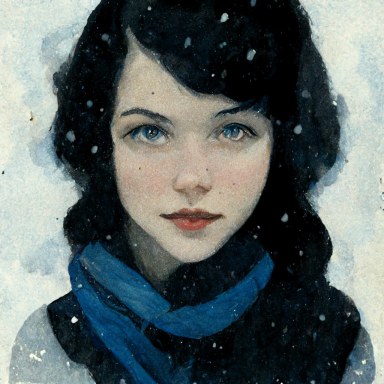30+ Movies to Watch While You’re High
Here are the best movies to watch while high 📽️🗿
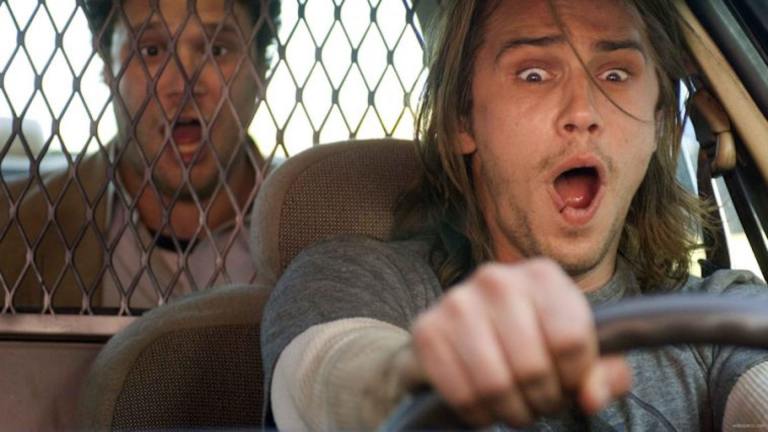
Some movies are simply weird or trippy or just so bad they are good. One doesn’t need to be high to enjoy such movies, although you can watch them completely sober and wind up feeling high.
The movies on this list are a little different than weird or trippy movies in the sense that drugs—usually marijuana—play a crucial role in the plot, and by smoking weed before watching the film, viewers feel more like participants than passive observers. Many of these films are also steeped in the drug lore surrounding marijuana.
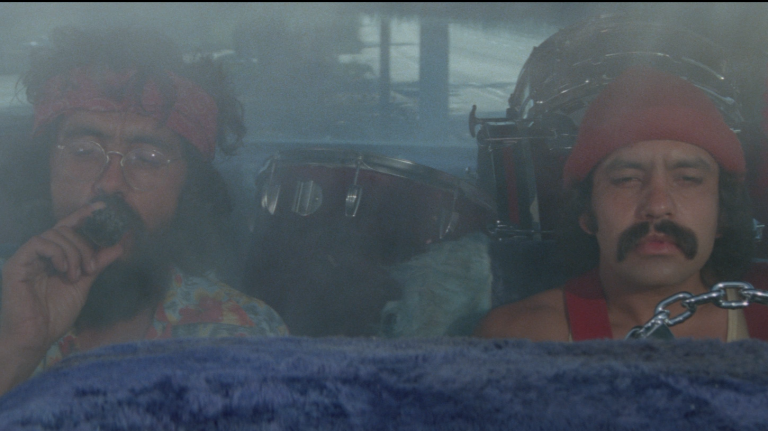
Then again, a minority of these films—such as Fantasia and 2001: A Space Odyssey—make no direct references to marijuana or drug use, but their psychedelic imagery attracted stoners to the extent that they “adopted” them as movies that must be watched while high.
Which leads to another question—if someone has to be high to enjoy the movie, does that mean it wouldn’t be a very good movie if you watched it while sober? That’s a deep philosophical question, and you may need to smoke a few joints while you read about the movies on this list.
Best Movies to Watch While High
Reefer Madness (1936)
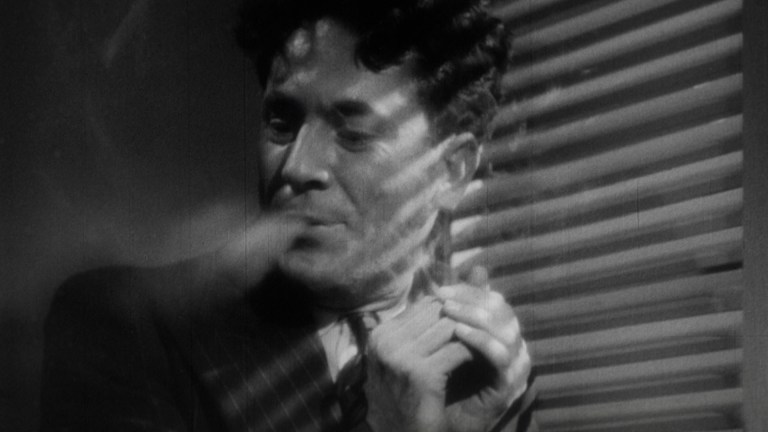
If paranoia about communism was known as the Red Scare, movies such as Reefer Madness were are the forefront of the Green Scare, a wave of over-the-top misinformation about the Demon Weed that warned anyone who even took a puff would become a hopelessly insane and possibly murderous addict. The film’s basic plot involves a trio of weed dealers who lure impressionable teens into smoking “reefer” cigarettes and the absolute ruination of their lives that naturally follows. The film was partially based on the real-life story of Victor Licata, a young man who axe-murdered his family in 1933 and was found to be under the influence of marijuana when he committed the crime. It’s pretty clear in retrospect that Licata was a schizophrenic with homicidal tendencies, but publicity around his crime led to the federal Marijuana Tax Act of 1937, which outlawed sales of weed in the USA. The film’s propaganda was so overwrought, hippies started flocking to midnight screenings of Reefer Madness in the 1970s just to get high and laugh. TimeOut writes, “It’s basically a lousily made film, but the one-dimensional ‘vice’ and portentous didacticism more than make up for that. One of the most absurdly earnest exercises in paranoia you’ll ever have the good fortune to see.”
Fantasia (1940)
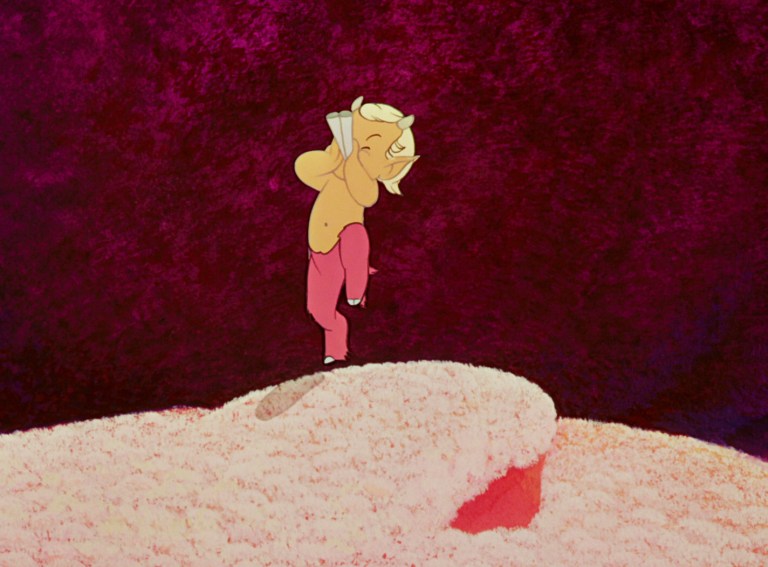
This was another movie like 2001: A Space Odyssey that was not directly intended as a “movie to watch while you’re high” but that pot-smoking and acid-dropping hippies latched onto due to its incredible mixture of animation and classical music. Choosing Fantasia as one of “20 Movies to Watch While You’re Stoned,” the LA Weekly wrote, “Walt Disney’s experimental extravaganza brings together animation and classical music. Beethoven, Stokowski, Stravinsky, Tchaikovsky. Hippos in tutus performing ballet, dancing flowers, [and] Mickey Mouse having a helluva time with mops and buckets.”
Rat Pfink a Boo Boo (1966)
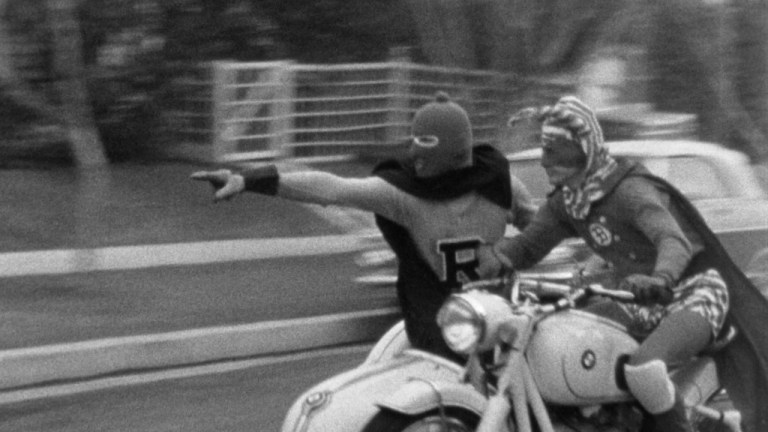
An absolute mess of a film that can only begin to make sense if you’re high—and even if you’re high, it makes no sense at all. Director Ray Dennis Steckler was known for such cinematic abortions as The Incredibly Strange Creatures Who Stopped Living and Became Mixed-Up Zombies, but he outdid (or “under-did”?) himself with this Grade-Z production that he claimed cost only $20 to make. According to legend, the typographer who rendered the opening titles misspelled the word “and” in the original title, Rat Pfink and Boo Boo, but Steckler claimed they didn’t have the $50 to correct the typo, so it stuck. (Steckler also later claimed that this was a lie and that his young daughter kept chanting “Rat Pfink a Boo Boo,” and he liked the way it sounded.) Barely an hour long and shot in black and white with NO natural ambient dialogue—any time you hear a character “speaking,” the dialogue is dubbed in—it starts out as a gritty crime drama where a trio of thugs seek to abduct and hold a rock star’s girlfriend named Cee Bee Beaumont (Steckler’s real-life wife, Carolyn Brandt) for ransom. Then, feeling as if the film was going nowhere, Steckler abruptly changed gears and made it a comic-book superhero movie where Rat Pfink and Boo Boo (two caped crusaders based on Batman and Robin as well as the mid-60s’ popularity of Ed Roth’s iconic “Rat Fink” cartoon character) seek to rescue Cee Bee not only from the thugs, but from a gorilla named Kogar. The film is peppered throughout with surprisingly catchy rock music. Indie Film Cafe writes, “For pure silly, whimsical fun, its really hard to beat this oddball whackadoodle comedy superhero movie featuring hot (for 1963) singer Lonnie Lord and mild mannered gardener Titus stepping into a closet to become the mighty Rat Pfink and Boo Boo!”
Yellow Submarine (1968)
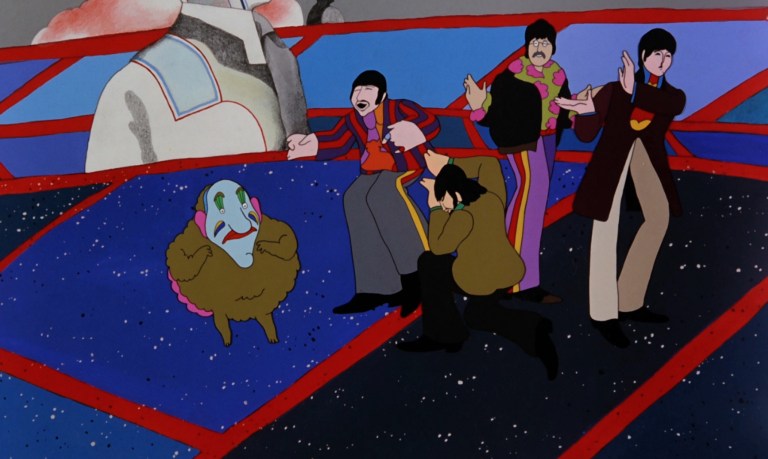
In a vividly psychedelic animated feature inspired in equal parts by marijuana culture and LSD culture, The Beatles travel in the eponymous Yellow Submarine deep into Pepperland, a mystical wonderworld deep beneath the sea. A group of music-hating killers known as Blue Meanies seek to eradicate all music from Pepperland, and this is one injustice The Beatles will not tolerate. Roger Ebert writes, “Yellow Submarine was also embraced as a ‘head movie,’ leading to an observation attributed to Ken Kesey: ‘They say it looks better when you’re stoned. But that’s true of all movies.’”
Head (1968)
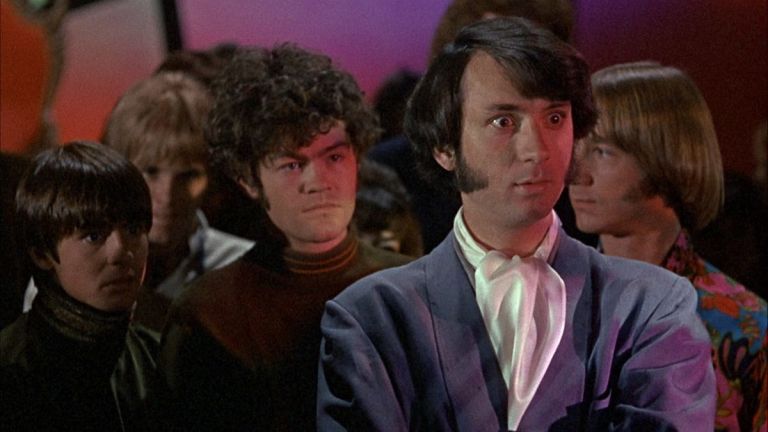
Marketed as “a movie for a turned-on audience”—meaning an audience that was high on illicit substances—this is the film that essentially destroyed the career of The Monkees, AKA “The American Beatles.” Whereas they were mostly known as an untalented pop group who sang insubstantial ditties and didn’t even play their own instruments, Head tosses The Monkees into a deep psychedelic stew of surrealist head-tripping. The screenplay was written by Jack Nicholson, and Head was produced and directed by the team of Bob Rafelson and Bert Schneider, who had created The Monkees hit TV show. Some speculate that the film was so weird, it was purposely intended to wreck The Monkees’ career. Roger Ebert writes, “I suppose it flopped in 1968 because Monkees fans were offended by it, and non-Monkees fans (i.e., anyone over 14, in either age or IQ) devoutly stayed away.”
2001: A Space Odyssey (1968)
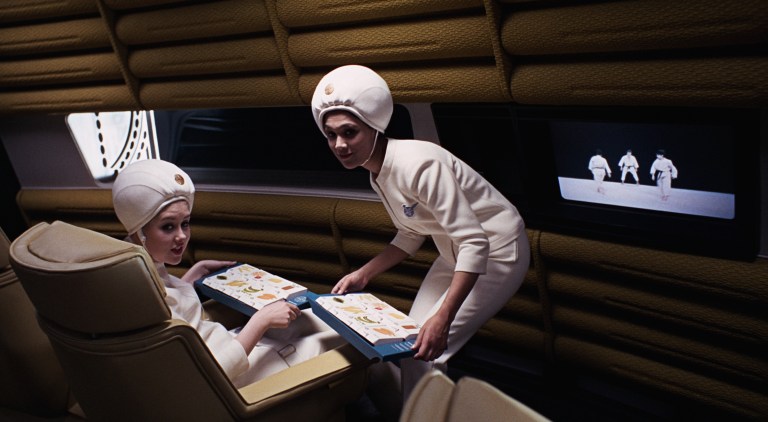
Director Stanley Kubrick’s game-changing foray into science fiction is considered by many to be one of the greatest films ever made. The basic “plot” involves the trajectory of human life from apes all the way to a transcendent future beyond Homo sapiens, with some dark drama in between involving a malevolent AI computer. The film’s last half hour is essentially a nonstop psychedelic head trip, which is what rallied hordes of hippies to flock to this film, which was marketed as the ultimate trio. Reel Views calls it “a cold, majestic motion picture, a movie that seeks to remind us of the vastness of space and our relatively insignificant place in it. Kubrick’s intention with 2001 was not to thrill us with battles and pyrotechnics, but to daunt us with the realization of how much there is that we do not understand.”
Easy Rider (1969)
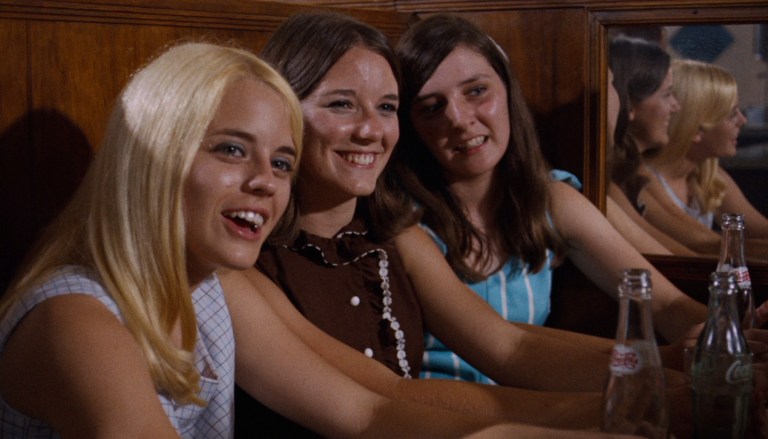
A hippie classic in which drugs play a prominent role. Director Dennis Hopper plays Billy, a scruffy biker who along with Captain America (Peter Fonda) set along on a journey from the West Coast to New Orleans after pocketing the money from a huge cocaine sale they made to an eccentric man (legendary record producer Phil Spector) in a Rolls-Royce on an airplane runway. As they travel through America, they visit hippie communes, get arrested in Texas for interrupting a parade, smoke plenty of weed with an alcoholic lawyer (Jack Nicholson) that they met in jail, and get increasingly harassed by intolerant locals as they plunge further into the Deep South. In New Orleans during Mardi Gras, they drop LSD with a pair of prostitutes (Karen Black and Tony Basil). Far Out magazine writes, “The film already contained scenes where the characters participated in smoking joints, but many thought that it wasn’t actually marijuana. It was later confirmed by the stars of the film, like Peter Fonda and Jack Nicholson, that the entire crew was using something or the order. Fonda recalled: ‘Everyone had their [medication] of choice on Easy Rider. [Hopper] had his drink, [Nicholson] smoked joints, and the crew dabbled with acid and dope.’ Since it was a Dennis Hopper project, this should come as no surprise as the man has done far more intense things like searching for death in a Mexican jungle and shooting up a tree while high on LSD, for example.”
El Topo (1970)
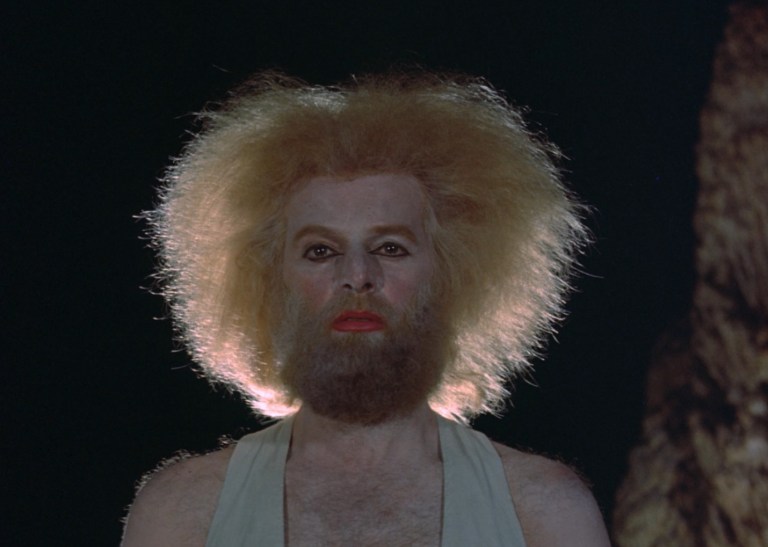
An extremely gory and trippy take on the Spaghetti Western genre by surrealist Chilean director Alejandro Jodorowsky, El Topo achieved a wide theatrical run and loads of controversy after John Lennon of The Beatles publicly declared his admiration for it. The lead character—named “El Topo” and played by the director—travels through the desert on horseback and leaves a trail of blood and guts in his wake. Roger Ebert writes, “El Topo is a picaresque journey past the principal myths and symbols of human culture, shot in the style of an incredibly bloody, violent Italian Western. People are going to it for all sorts of reasons. As a greasy, grimy, gore-dripping Western, it works just fine, and not even the early Clint Eastwood films had so much sweat and sadism.”
The Holy Mountain (1973)
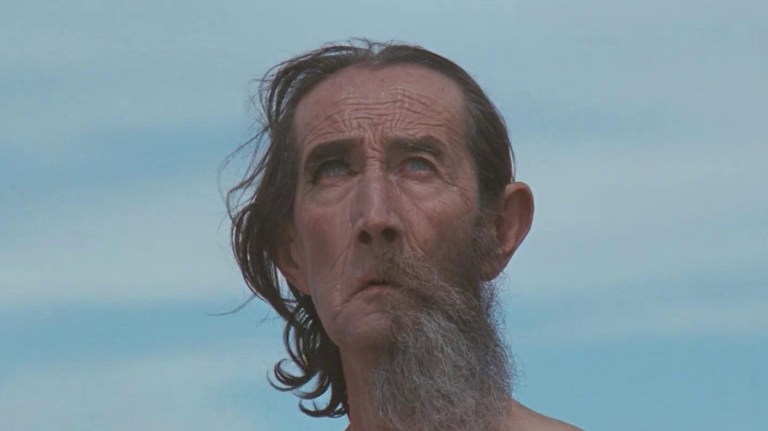
Jodorowsky’s third film received a tremendous boost when Beatles John Lennon and George Harrison, both admirers of El Topo, helped finance the project, which was produced by Beatles manager Allen Klein. A reviewer for TimeOut writes that Jodorowsky’s approach was to “Keep the concept of cinema as a one-stop head shop—only this time, start shoving once you reach the outer limits. Then, for good measure, add in Marxist mumbo-jumbo, amputees, hermaphrodites, astrology, cannibalism and chimpanzees; make the whole enchilada BYOC (Bring Your Own Coherence), and voila!” Basement Rejects writes, “I’ve seen El Topo and I’ve seen Santa Sangre, and I know that Jodorowsky is a complete trip. You can’t go into the films with any expectations (except the promise of unique visuals). While both El Topo and Santa Sangre are ‘trippy,’ The Holy Mountain takes it to another level.”
Up in Smoke (1978)
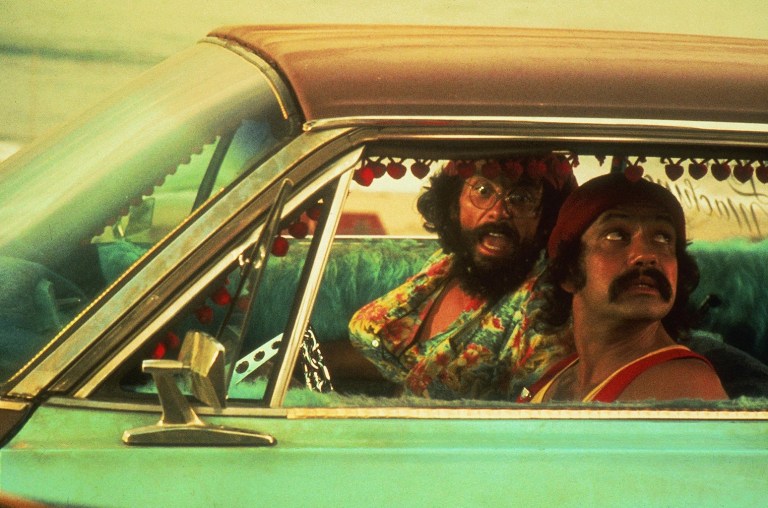
More than any other comedians in the 1960s and 1970s, the comic duo of “Cheech” Marin and Tommy Chong built a career on weed references and weed humor. In this, their debut film, Chong portrays Anthony Stoner, an unemployed rock drummer who never does much besides smoke weed and mumble incoherently. After he meets Pedro de Pacas (Cheech Marin), the two get arrested for marijuana possession but are released on a technicality, allowing them to compete in a rock-band contest at the film’s climax. Entertainment Weekly writes, “In their debut, Cheech & Chong’s Up in Smoke, they’re jobless musician wannabes who flummox an authority figure (narc Stacy Keach) and get laughs from simple, otherwise meaningless gestures and exchanges (‘Hey, man.’ ‘What?’ ‘What?’ ‘Oh’). Through encounters with cops, criminals, babes, and bozos, they’re always there for each other.”
Cheech & Chong’s Nice Dreams (1981)
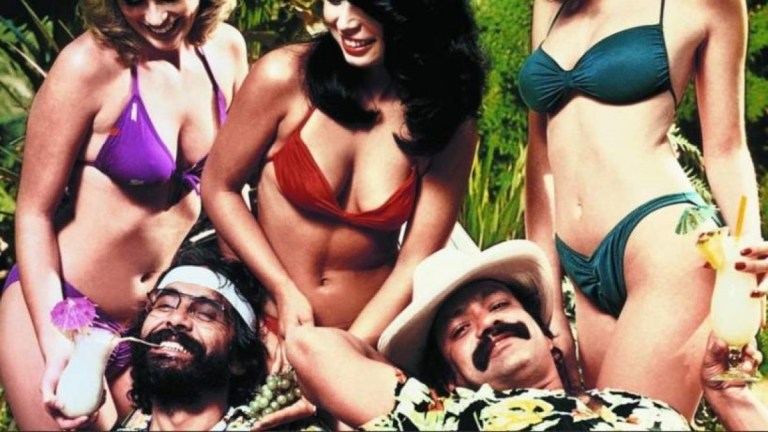
In Cheech & Chong’s third film after Up in Smoke (1978) and Cheech & Chong’s Next Movie (1980), the world’s most famous potheads stumble across a super-potent strain of weed that just so happens to gradually turn its users into reptiles. They start selling the unique brand of weed from an ice-cream truck while evading a lawman who seeks to jail them not only for selling drugs, but for enabling the transformation of human beings into reptiles. TimeOut writes, “their third movie is where shit starts to get really weird….Cue odd non-sequiturs involving characters named ‘Howie Hamburger’ and ‘Weird Jimmy’, an acid trip in a mental asylum, cameos from Paul Reubens and LSD pioneer Timothy Leary, and a weed strain that slowly turns consumers into lizards….”
Dazed and Confused (1993)
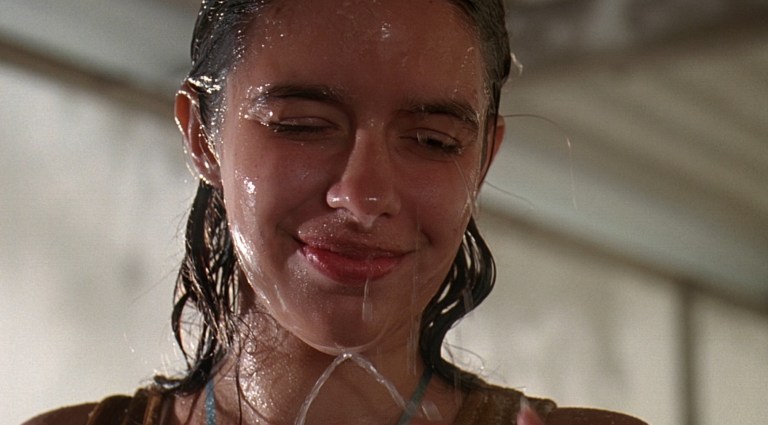
The bicentennial year of 1976 may have marked the peak of drug culture and stoner culture in America, and this loving ode to that era by director Richard Linklater all takes place over the course of the last day of high school as a group of graduating seniors try to plot the course for the rest of their lives. It’s very similar to American Graffiti in the sense that it features an ensemble cast of actors on the last day of high school attempting to figure out what comes next, but whereas American Graffiti successfully took the viewer back in time to 1961, Dazed and Confused is firmly placed in 1976. The Washington Post writes, “Richard Linklater’s satirical take on high school life in the 1970s is not only funny and entertaining. It’s practically a historic document of life during the smiley-face button era–when people wore wide-bottomed pants, listened to Edgar Winter and (to paraphrase a Dazed and Confused ad banned by the Motion Picture Association of America) actually inhaled when they smoked marijuana.”
Friday (1995)
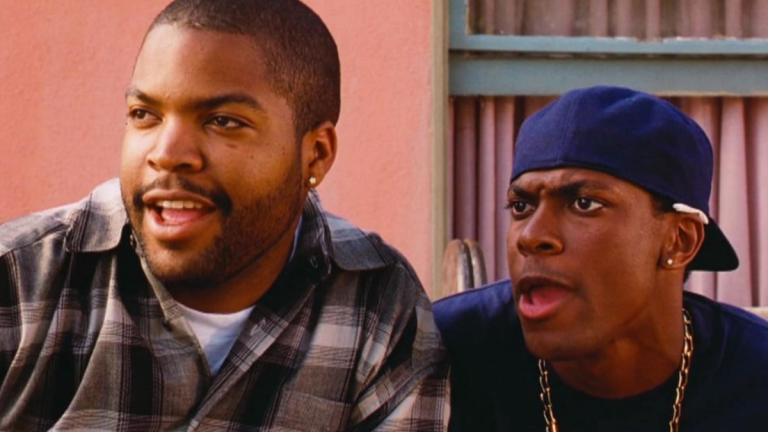
Possibly the first blaxploitation film that also fits neatly into the stoner-movie genre, rapper Ice Cube’s homage to a typical Friday in the ’hood revolves around the character Chris Jones (Ice Cube) and his attempt to extricate his foul-mouthed friend Smokey (Chris Tucker in his breakout role) from a dangerous situation due to the fact that he owes a ruthless local weed dealer some money. According to Music Box Theatre, “As the hours drag on, Jones and Smokey experience the gamut of urban life, complete with crackheads, shoot-outs and overly sexual pastors, concentrated into one single, unbelievable Friday.”
The Big Lebowski (1998)

The Coen Brothers’ comedy thriller revolves around Jeff “The Dude” Lebowski (Jeff Bridges), a lovable, wise, and yet entirely slovenly and lazy pothead who gets mistaken for a millionaire named Lewbowski by hired thugs who wind up peeing on The Dude’s beloved throw rug, leading The Dude on a campaign of vengeance and clarification. Roger Ebert writes, “Some may complain The Big Lebowski rushes in all directions and never ends up anywhere. That isn’t the film’s flaw, but its style. The Dude, who smokes a lot of pot and guzzles White Russians made with half-and-half, starts every day filled with resolve, but his plans gradually dissolve into a haze of missed opportunities and missed intentions.”
Fear and Loathing in Las Vegas (1998)
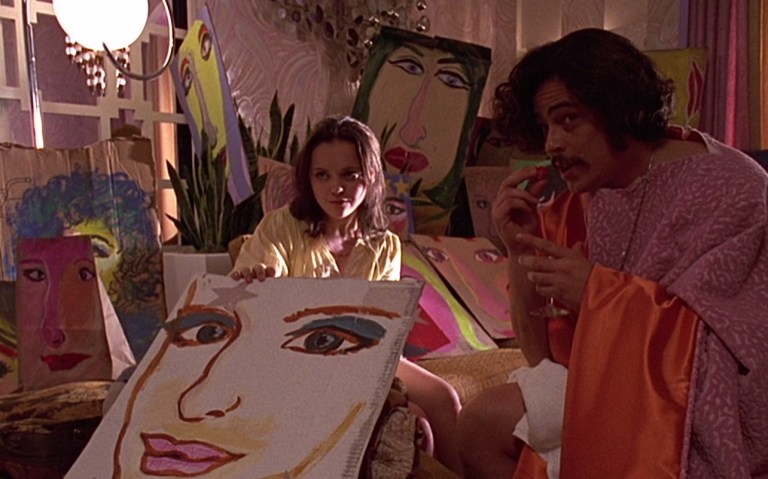
Hunter S. Thompson’s visionary 1971 book Fear and Loathing in Las Vegas may the the best-loved book of all time in which the protagonists consume ungodly amounts of drugs—including a harrowing experience ingesting raw human adrenaline—without going completely bonkers. Johnny Depp portrays Raoul Duke and Benicio Del Toro plays his trusty lawyer friend Dr. Gonzo as the pair head to Las Vegas to cover a motorcycle race. The New York Times writes, “Revisiting Thompson’s 1971 book, the enthusiastic full-tilt stamina of the author’s alter ego, Raoul Duke, and his lawyer and partner-in-mayhem, Dr. Gonzo, is still infectious in its dated way. As they roar through Las Vegas like a pair of runaway trains, nothing derails them, even when the surrounding landscape seems to shatter into ghoulish hallucinatory shards. The pharmaceuticals they consume by the fistful seem to work as physical as well as psychic fuel for their outrageous drug-addled investigation of the garish side of the American dream at a moment when the world seems divided into two mutually hostile camps: the insolent hip and the grimly square.”
Half Baked (1998)
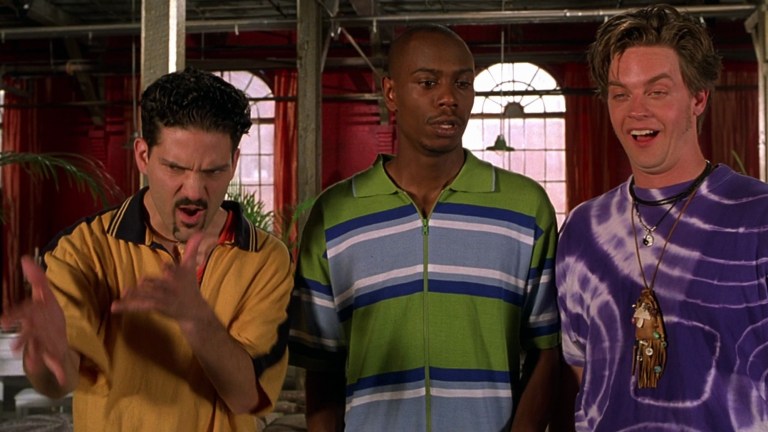
Thurgood (Dave Chappelle), Scarface (Guillermo Diaz), and Brian (Jim Breuer) are a trio of potheads whose friend is jailed after he accidentally kills a New York City police horse by feeding it junk food. To raise bail for their friend’s release, they break into a pharmaceutical lab, steal some high-grade weed, and try to sell it while evading the police. Saying that Chappelle’s goal with the film was to “revive the stoner comedy,” Time Out writes, “It had been a good while since there’d been a movie made explicitly for potheads, by potheads, and while critics hated it, it was adopted by red-eyed ’90s kids as the Up in Smoke of their generation.”
Dude, Where’s My Car? (2000)

Ashton Kutcher and Seann William Scott star as a pair of hard-partying dudes who had such a fantastic time the previous night, they can’t even find where they parked their car once they sober up the next morning. They attempt to retrace the previous night’s steps, leading to all sorts of botching and bungling and misadventure. The BBC suggests that one might have to actually be high to enjoy this movie: “Jesse and Chester’s Abbott-and-Costello-style routines (directionless duologues in which every other word is ‘dude’ or ‘sweet’) are painfully unamusing, and you would surely have to be on drugs yourself to make sense of a storyline which incorporates ostriches, tattoos, and a flatmate who urinates in flower pots.”
Pootie Tang (2001)
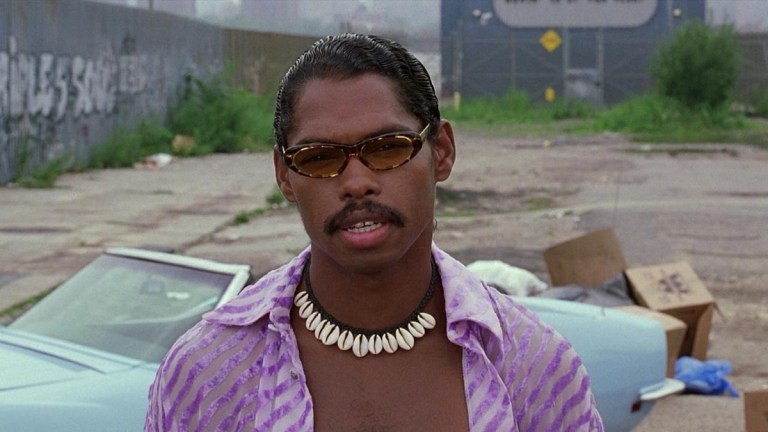
Based on a sketch from HBO’s The Chris Rock Show and with a script written by Louis C.K., the film’s title refers to its main character, a ghetto superstar with an odd way of speaking who uses his magical belt to protect women and children in the ‘hood. Chris Rock has a cameo appearance as a talking corn cob. SF Gate writes, “Pootie is a ghetto superstar par excellence–corny-cool right down to his cheap, tinted shades and wide-open short-sleeve shirts. He looks like a Commodore trying to get backstage at a Teena Marie-Rick James concert….The film is out to mock the place where hip-hop and blaxploitation meet. As it turns out, the shoddy assembly and low-budget sheen are its best critique of the retro-fabulousness the film is satirizing.”
Harold & Kumar Go to White Castle (2004)

Harold (John Cho) and Kumar (Kal Penn) are a pair of college roommates who get high one night and are mesmerized by a TV ad for White Castle, an extremely popular chain of low-grade burger shops across the Northeast. Beset with a vicious case of the munchies and convinced that there must be a White Castle somewhere near their North Jersey apartment, they drive into the dark wilds of the Garden State and encounter one hilarious situation after the next. Salon writes, “Even when they’re over the top, the gags in Harold & Kumar have a kind of Zen garden simplicity — they don’t demand brains or logic as much as a willingness to surrender to the corner of your brain that sometimes forgets how to spell words like ‘accommodate’ and ‘likability.’”
Smiley Face (2007)

Anna Faris assumes the title role in Gregg Araki’s film about a struggling actress who is unmotivated due to the fact that she smokes weed from the minute she wakes up in the morning to when she finally falls asleep at night. She has a busy day planned, but when she eats a potent cupcake infused with THC, she is instead set upon a path of misdirection and chaos throughout LA. A reviewer for the Village Voice writes that although he can’t stand marijuana or stoner culture, he “can say with some authority that Dylan Haggerty has written an eleventh-hour candidate for the funniest movie of 2007, that Gregg Araki has directed his finest film since 1997’s Nowhere, and that Faris, flawless, rocks their inspired idiot odyssey in a virtuoso comedic turn.”
Pineapple Express (2008)

Seth Rogen plays a stoner named Dale Denton who becomes obsessed with a super-powerful strain of weed known as Pineapple Express. But he drops a roach accidentally while witnessing a murder. When Dale and his weed dealer friend (James Franco) realize that the roach can be traced back to them and may falsely implicate them in the murder, they go on the run. A malevolent drug lord (Gary Cole) and a corrupt cop (Rosie Perez) both have their reasons for bringing the boys to justice. Roger Ebert writes, “Pineapple Express has all the elements you’d expect from the genre: male bonding, immature sexual desires, verbal scatology, formidable drug abuse, fight scenes, gunfire, explosions. Yawn? Not this time. It’s a quality movie even if the material is unworthy of the treatment. As a result, yes, it’s a druggie comedy that made me laugh.”
Enter the Void (2009)
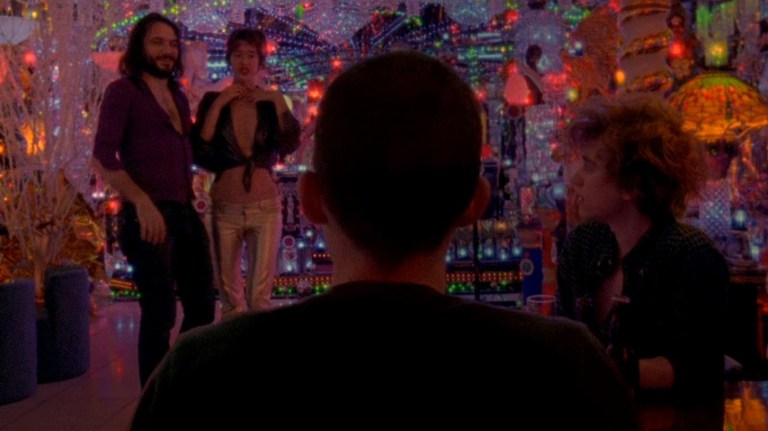
Director Gaspar Noé’s nearly unwatchable 2002 film Irreversible placed him on the map as an auteur with a rare ability to evoke mind-bending levels of disgust. Enter the Void takes place in Japan, where police kill a drug dealer named Oscar, allowing viewers to witness firsthand his nightmarish descent into the afterlife. Salon writes, “This powerful, hallucinogenic journey will strike some viewers as a flat-out masterpiece and others as flatulent garbage. It actually has elements of both, so let me issue a completely weaselly, asterisk-laden recommendation: You have to see this! If (and only if) you’re into this kind of thing!”
Samsara (2011)

Director Ron Fricke was the cinematographer for the renowned 1982 documentary Koyaanisqatsi, which was notable in that it contained no dialogue and instead was a pastiche of music and footage of natural and urban landscapes. Fricke went on to direct Chronos (1985) and Baraka (1992) in much the same vein, using sweeping cinematography and a dialogue-free approach to overwhelm the viewer in an ocean of music and images. In Samsara, Fricke and his crew traveled to five continents, capturing footage of waterfalls, the Egyptian pyramids, the Roman catacombs, and New Orleans after the devastation of Hurricane Katrina. DVD Infatuation writes, “Shot on 70mm, Samsara, like Chronos and Baraka before it, acts as a window to the world, through which we see many interesting things. Awe-inspiring and occasionally shocking, Samsara is guaranteed to blow you away.”
This is the End (2013)
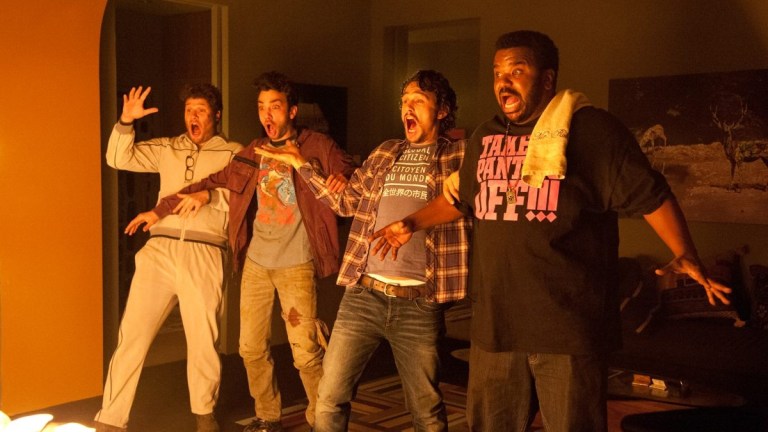
James Franco and Seth Rogen—who were integral to the stoner classic Pineapple Express—return for this apocalyptic comedy where a group of celebrities who attend a party at Franco’s house wind up trapped in his mansion after Los Angeles has been destroyed. Much of the comedy is wrought not by the group’s struggles to survive the apocalypse, but the fact that their involuntary quarantining has forced them to take a hard look at themselves.
Inherent Vice (2015)
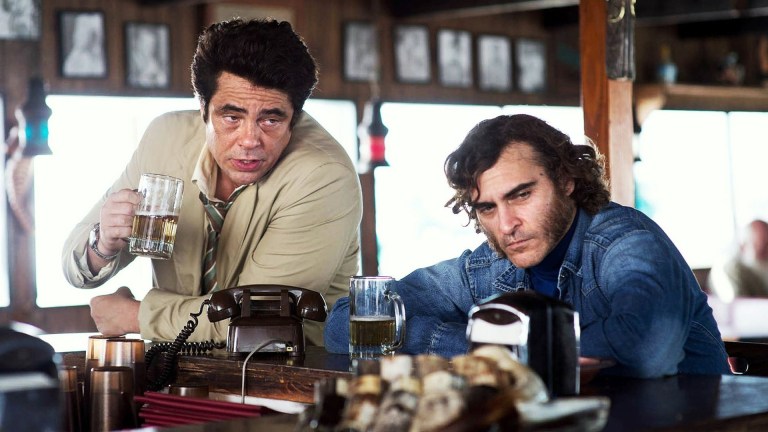
In Paul Thomas Anderson’s adaptation of a psychedelic novel by Thomas Pynchon, Joaquin Phoenix plays a private detective named Larry “Doc” Portello, who lives in a California beach community and tries to solve cases despite being perpetually zonked on marijuana. Reel Views writes, “There’s slapstick, lowbrow material, and enough strange characters and ‘completely different’ moments to make Monty Python smile….The whole of Inherent Vice takes place in the haze of smoke from the pot incessantly smoked by the lead character, private investigator Larry ‘Doc’ Sportello (played with low-key intensity by Joaquin Phoenix). By intent, there’s not a lot of energy in the film; it’s mellow and slow-moving.”
More Movies to Watch While High
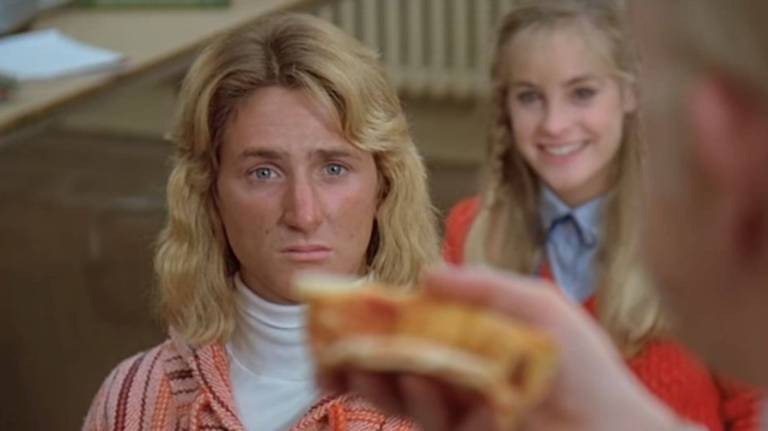
- Assassin of Youth (1938) is nearly as hysterical as the previous year’s Reefer Madness in its insistence that even a puff of the Devil’s weed will lead one down a path of destruction.
- More (1969) focuses on heroin addiction and has a soundtrack by Pink Floyd.
- Fantastic Planet (1973) is an animated French-Czech coproduction that relies heavily on trippy imagery.
- Heavy Metal (1981) named after the graphics-intensive magazine popular in the 1970s and 1980s, this is a series of animated shorts that focus on alternative psychological states.
- Fast Times at Ridgemont High (1982) is perhaps best known for Sean Penn’s star-making role as Jeff Spicoli, the quintessential California stoner dude.
- Bill & Ted’s Excellent Adventure (1989) although light on drug references, this comedy is heavy on improbably psychedelic situations as a group of wannabe rock stars travel in time to help form the perfect band.
- Requiem for a Dream (2000) is director Darren Aronofsky’s nightmare film about the ravages of addiction.
- Higher Ed (2001) a man enters college on a track scholarship and struggles to evade the druggy lifestyle of the hood from which he came.
- How High (2001) Rap stars Redman and Method Man play a pair of stoners who wind up as students at Harvard University after smoking some suspicious weed.
- Jay and Silent Bob Strike Back (2001) Kevin Smith’s mumbling antiheroes fight a movie production that seeks to capitalize on their comic-book stoner alter egos.
- Super Troopers (2002) a group of bored and bumbling Vermont State Troopers seek to amuse themselves.
- Soul Plane (2004) hijinks and hilarity erupt when a group of entrepreneurs attempt to start an airline that caters to black people.
- Grandma’s Boy (2006) a game designer interrupts his bitter rivalry with another game designer to focus on a girl.
- Tenacious D in: The Pick of Destiny (2006) Jack Black’s hilarious rock band is back in a comedy about finding the “Holy Grail” of guitar picks.
- Ted (2012) is on this list mainly because people are apt to find a talking teddy bear funnier when they’re stoned.
- We’re the Millers (2013) a bumbling family down on their luck must make a drug shipment from Mexico to America in order to pay off a debt.
